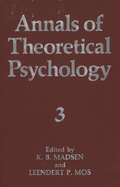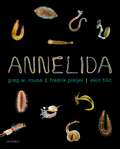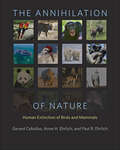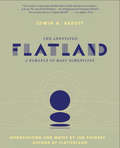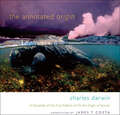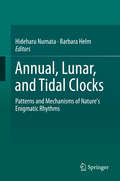- Table View
- List View
Annals of Systems Research: Volume 6 (Annals of Systems Research #6)
by H. Koppelaar B. Van RootselaarAnnals of Systems Research: Publikatie van de Systeemgroep Nederland Publication of the Netherlands Society for Systems Research (Annals of Systems Research #5)
by B. Van RootselaarAnnals of Systems Research: Publikatie van de Systeemgroep Nederland / Publication of the Netherlands Society for Systems Research (Annals of Systems Research #1)
by B. Van RootselaarAnnals of Systems Research: Publikatie van de Systeemgroep Nederland Publication of the Netherlands Society for Systems Research (Annals of Systems Research #3)
by B. Van RootselaarAnnals of Theoretical Psychology: Volume 3
by K. B. Madsen Leendert P. MosAs a follow up to Volume 7, contributors continue to explore the latest developments in developmental psychology. Here, researchers focus on the integration of theory and research and evaluates theoretical progress and advanced research. Continuing with the successful format of previous volumes in Annals of Theoretical Psychology, Volume 10 presents four major contributions--each accompanied by commentaries and replies to commentaries.
Annals of Theoretical Psychology (Annals of Theoretical Psychology #4)
by Leendert P. MosThis discipline has become more reflective in recent years. It has also become blatantly philosophical, which is itself cause for reflection. The philosophy of psychology has not been exactly a burgeoning field, and yet psychologists and philosophers of all persuasions are writing philosophical psychology. Perhaps all this activity merely reflects the uneasy bifurcation of psychology into biological and cognitive domains. After all, there were similar flurries in the 1920s and 1950s when the discipline assumed new directions. But, before, there were too many things to do; scientific knowing seemed so compelling and so singular in methodology. Today, the entire enterprise is much more uncertain, and not just psychology, but all human scientific inquiry. The fun damental questions remain much the same, of course; what has changed is that philosophers are explicitly addressing questions of psy chology and psychologists are at least implicitly engaged in philosophy. The bounderies are no longer clear cut! Theoretical psychology is as much the doing of philosophy as it is of experimental research. Volume 4 of these Annals attests to this state of affairs. The psychologists' style reflects their philosophical understanding; the philosophers differ according to what they take to be psychological knowledge.
Annals of Theoretical Psychology: Volume 1
by Joseph R. RoyceSome one hundred years ago the founding fathers optimistically launched psychology as a science. The premise was that the new science must break away from its parental ties to philosophy and confine itself to gathering data, preferably in the psychology laboratory. There is little doubt that this early commitment to an "observation and accumulation of data only" policy was helpful in the launching of the new science. Some idea of how critical this move to empiricism was can be gathered from the following quotation taken from Wolman (1973, p. 32): It was not an easy task to transform the old "mental philosophy" into a natural science. Natural science used observation and experimentation; they observed their subject matter, as it were, from without. Wundt's psychology was supposed to study observable stimuli and responses, but there was so much that was unobservable in psychology. Although the launching was eventually a success, there is little doubt that the high hopes of the founding fathers have not materialized.
Annals of Theoretical Psychology: Volume 2
by Joseph R. Royce Leendert P. MosAs such things happen, several manuscripts in the present volume were under review prior to the ones that appeared in Volume I of the Annals. A major difficulty encountered in the preparation of these volumes apart from working up to three years in advance of publication-is elic iting appropriate commentary. If this format is to succeed, the com mentary must be both engaging to the reader and satisfying to the author. It is not yet clear how successful we have been in this regard and, indeed, we do not feel bound to publish commentary with each manuscript that is accepted for publication. Nevertheless, we do invite readers' commentaries on published materials. The contributions by Jan Smedslund and Benjamin Wolman in this volume have been through an inordinately long publication lag. We have been in receipt of both manuscripts since early in 1981 and Dr. Smedslund, especially, has since clarified and advanced his views else where in print. K. B. Madsen and Joseph Rychlak submitted their man uscripts in the fall of 1981 while Michael Hyland and J. Philippe Rushton had first drafts of their manuscripts accepted for publication in the fall of 1982. We are grateful to our contributors for their expressed com mitment to the Annals and assure potential contributors that the delay in publication is a mere matter of getting the series off the ground.
Annelida
by Greg Rouse Fredrik Pleijel Ekin TilicAnnelids (the segmented worms) exist in a remarkably diverse range of mostly marine but also freshwater and terrestrial habitats, varying greatly in size and form. Annelida provides a fully updated and expanded taxonomic reference work which broadens the scope of the classic Polychaetes (OUP, 2001) to encompass wider groups including Clitellata (comprising more than a third of total annelid diversity), Sipuncula, and Thalassematidae (formerly Echiura). It reflects the enormous amount of research on these organisms that has burgeoned since the millennium, principally due to their use as model organisms to address wider and more general evolutionary and ecological questions. Beginning with a clear introduction to the phylum and an outline of annelid taxonomy, this authoritative text describes their collection, the methods to ensure their optimal preservation, and an overview of anatomy with its relevant terminology. The core of the work comprises 77 fully up-to-date taxonomic chapters, informed by anatomy and the latest molecular phylogenomic evidence and carefully organised based on a new, robust phylogenetic hypothesis. Lavishly illustrated throughout with hundreds of previously unpublished high-resolution colour images and SEM micrographs, the sheer beauty and diversity of the annelids is nowhere better presented. Annelida is the definitive reference work for annelid biologists, whilst being of interest to a broader audience of invertebrate zoologists, systematists, and organismal biologists.
Annelids in Modern Biology
by Daniel H. ShainAnnelids offer a diversity of experimentally accessible features making them a rich experimental subject across the biological sciences, including evolutionary development, neurosciences and stem cell research. This volume introduces the Annelids and their utility in evolutionary developmental biology, neurobiology, and environmental/ecological studies, including extreme environments. The book demonstrates the variety of fields in which Annelids are already proving to be a useful experimental system. Describing the utility of Annelids as a research model, this book is an invaluable resource for all researchers in the field.
Annie B., Made for TV
by Amy DixonFor every kid who's ever come in second place, this is a middle grade story about chasing your dreams. Eleven-year-old Annie Brown is used to being on the losing end of comparisons to her almost-always best friend Savannah. Savannah is MVP of the track team, has straight As, and, predictably, wins the most coveted school spirit award on the last day of 5th grade. Fortunately, Annie does have one very specialized skill. Inspired by As Seen on TV commercials, Annie likes to invent products and write clever sales pitches to go along with them. So when an opportunity arises to audition for a local web show called The Cat's Meow, Annie knows her future is set. She's going to wow those producers with her fabulous writing and made-for-TV announcer voice. Of course, things don't happen quite according to plan, and soon Annie is worried about losing both the opportunity she's been training for her whole life, and her best friend.
The Annihilation of Nature: Human Extinction of Birds and Mammals
by Paul R. Ehrlich Anne H. Ehrlich Gerardo Ceballos Ding Li YongGerardo Ceballos, Anne H. Ehrlich, and Paul R. Ehrlich serve as witnesses in this trial of human neglect, where the charge is the massive and escalating assault on living things. Nature is being annihilated, not only because of the human population explosion, but also as a result of massive commercial endeavors and public apathy. Despite the well-intentioned work of conservation organizations and governments, the authors warn us that not enough is being done and time is short for the most vulnerable of the world’s wild birds and mammals. Thousands of populations have already disappeared, other populations are dwindling daily, and soon our descendants may live in a world containing but a minuscule fraction of the birds and mammals we know today.The Annihilation of Nature is a clarion call for engagement and action. These outspoken scientists urge everyone who cares about nature to become personally connected to the victims of our inadequate conservation efforts and demand that restoration replace destruction. Only then will we have any hope of preventing the worst-case scenario of the sixth mass extinction.
Anniversary Volume on Approximation Theory and Functional Analysis (International Series of Numerical Mathematics #65)
by P. L. Butzer R. L. Stens B. Sz.-NagyThese Proceedings include 42 of the 49 invited conference papers, three papers sub mitted subsequently, and a report devoted to new and unsolved problems based on two special problem sessions and as augmented by later communications from the participants. In addition, there are four short accounts that emphasize the personality of the scholars to whom the proceedings are dedicated. Due to the large number of contributors, the length of the papers had to be restricted. This volume is again devoted to recent significant results obtained in approximation theory, harmonic analysis, functional analysis, and operator theory. The papers solicited include in addition survey articles that not only describe fundamental advances in their subfields, but many also emphasize basic interconnections between the various research areas. They tend to reflect the range of interests of the organizers and of their immediate colleagues and collaborators. The papers have been grouped according to subject matter into ten chapters. Chap ter I, on operator theory, is devoted to certain classes of operators such as contraction, hyponormal, and accretive operators, as well as to suboperators and semi groups of operators. Chapter II, on functional analysis, contains papers on function spaces, algebras, ideals, and generalized functions. Chapter III, on abstract approximation, is concerned with the comparison of approximation processes, the gliding hump method, certain inter polation spaces, and n-widths.
The Annotated Flatland: A Romance of Many Dimensions
by Ian StewartFlatland is a unique, delightful satire that has charmed readers for over a century. Published in 1884 by the English clergyman and headmaster Edwin A. Abbott, it is the fanciful tale of A. Square, a two-dimensional being who is whisked away by a mysterious visitor to The Land of Three Dimensions, an experience that forever alters his worldview.Like the original, Ian Stewart's commentary takes readers on a strange and wonderful journey. With clarity and wit, Stewart illuminates Abbott's numerous Victorian references and touches on such diverse topics as ancient Babylon, Karl Marx, Mary Shelley's Frankenstein, Mt. Everest, H.G. Wells, and phrenology. The Annotated Flatland makes fascinating connections between Flatland and Abbott's era, resulting in a classic to rival Abbott's own, and a book that will inspire and delight curious readers for generations to come.
The Annotated Flatland: A Romance of Many Dimensions
by Ian StewartFlatland is a unique, delightful satire that has charmed readers for over a century. Published in 1884 by the English clergyman and headmaster Edwin A. Abbott, it is the fanciful tale of A. Square, a two-dimensional being who is whisked away by a mysterious visitor to The Land of Three Dimensions, an experience that forever alters his worldview.Like the original, Ian Stewart's commentary takes readers on a strange and wonderful journey. With clarity and wit, Stewart illuminates Abbott's numerous Victorian references and touches on such diverse topics as ancient Babylon, Karl Marx, Mary Shelley's Frankenstein, Mt. Everest, H.G. Wells, and phrenology. The Annotated Flatland makes fascinating connections between Flatland and Abbott's era, resulting in a classic to rival Abbott's own, and a book that will inspire and delight curious readers for generations to come.
The Annotated Hodgkin and Huxley: A Reader's Guide
by Indira M. Raman David L. FersterThe first annotated edition of the scientific papers that created the foundation of modern neuroscience and physiology The origin of everything known about how neurons and muscles generate electrical signals can be traced back to five revolutionary papers, published in the Journal of Physiology in 1952 by Alan Hodgkin and Andrew Huxley. The principles they revealed remain cornerstones of the discipline, summarized in every introductory neuroscience and physiology course. Since that era, however, scientific practice, technology, and presentation have changed extensively. It is difficult for the modern reader to appreciate Hodgkin and Huxley’s rigorous scientific thought, elegant experimental design, ingenious analysis, and beautiful writing.This book provides the first annotated edition of these papers, offering essential background on everything, from terminology, equations, and electronics, to the greater historical and scientific context surrounding the work. The original journal pages are displayed opposite detailed notes explaining content, process, and background, with copies of the figures replotted according to modern conventions. Indispensable for scientists, teachers, and trainees alike, The Annotated Hodgkin and Huxley makes an essential body of knowledge—and an unparalleled approach to research—accessible to a new generation of readers.Reproduces the original articles paired with extensive annotations on facing pagesReplots figures with modern conventions of data displayExplains the development of the voltage clamp and the discovery of ionic currents and action potential generation, foundational to the study of neuroscience and physiologySummarizes the history of electrophysiology leading to Hodgkin and Huxley’s workIncludes appendices on relevant concepts from mathematics, physics, electronics, chemical kinetics, and numerical methods
The Annotated Origin: A Facsimile of the First Edition of <i>On the Origin of Species</i>
by Charles DarwinCharles Darwin’s On the Origin of Species is the most important and yet least read scientific work in the history of science. Now James T. Costa—experienced field biologist, theorist on the evolution of insect sociality, and passionate advocate for teaching Darwin in a society in which a significant proportion of adults believe that life on earth has been created in its present form within the last 10,000 years—has given a new voice to this epochal work. By leading readers line by line through the Origin, Costa brings evolution’s foundational text to life for a new generation. The Annotated Origin is the edition of Darwin’s masterwork used in Costa’s course at Western Carolina University and in Harvard’s Darwin Summer Course at Oxford. A facsimile of the first edition of 1859 is accompanied by Costa’s extensive marginal annotations, drawing on his extensive experience with Darwin’s ideas in the field, lab, and classroom. This edition makes available an accessible, useful, and practical resource for anyone reading the Origin for the first time or for those who want to reread it with the insights and perspective that a working biologist can provide.
Annotations to Quantum Statistical Mechanics
by In-Gee KimThis book is a rewritten and annotated version of Leo P. Kadanoff and Gordon Baym’s lectures that were presented in the book Quantum Statistical Mechanics: Green’s Function Methods in Equilibrium and Nonequilibrium Problems. The lectures were devoted to a discussion on the use of thermodynamic Green’s functions in describing the properties of many-particle systems. The functions provided a method for discussing finite-temperature problems with no more conceptual difficulty than ground-state problems, and the method was equally applicable to boson and fermion systems and equilibrium and nonequilibrium problems. The lectures also explained nonequilibrium statistical physics in a systematic way and contained essential concepts on statistical physics in terms of Green’s functions with sufficient and rigorous details. In-Gee Kim thoroughly studied the lectures during one of his research projects but found that the unspecialized method used to present them in the form of a book reduced their readability. He started the tedious work of rewriting and annotating them to fully understand the formalism of nonequilibrium quantum statistical mechanics. While doing so, he realized they can be a useful resource for students of modern physics but will have to be upgraded to match pace with the evolved curricula. Being aware that besides completing the course work and passing the relevant examinations, it is necessary for graduate students of modern physics to make the knowledge of a topic concrete in their minds. This book is a systematically prepared summary of those lectures and will be extremely useful for graduate students as well as senior researchers to settle down the key knowledge of the subject.
Annotations to Quantum Statistical Mechanics
by In-Gee KimThis book is a rewritten and annotated version of Leo P. Kadanoff and Gordon Baym’s lectures that were presented in the book Quantum Statistical Mechanics: Green’s Function Methods in Equilibrium and Nonequilibrium Problems. The lectures were devoted to a discussion on the use of thermodynamic Green’s functions in describing the properties of many-particle systems. The functions provided a method for discussing finite-temperature problems with no more conceptual difficulty than ground-state problems, and the method was equally applicable to boson and fermion systems and equilibrium and nonequilibrium problems. The lectures also explained nonequilibrium statistical physics in a systematic way and contained essential concepts on statistical physics in terms of Green’s functions with sufficient and rigorous details. In-Gee Kim thoroughly studied the lectures during one of his research projects but found that the unspecialized method used to present them in the form of a book reduced their readability. He started the tedious work of rewriting and annotating them to fully understand the formalism of nonequilibrium quantum statistical mechanics. While doing so, he realized they can be a useful resource for students of modern physics but will have to be upgraded to match pace with the evolved curricula. Being aware that besides completing the course work and passing the relevant examinations, it is necessary for graduate students of modern physics to make the knowledge of a topic concrete in their minds. This book is a systematically prepared summary of those lectures and will be extremely useful for graduate students as well as senior researchers to settle down the key knowledge of the subject.
Annual Fishes: Life History Strategy, Diversity, and Evolution
by Nibia Berois Graciela García Rafael O. De SáAnnual Fishes: Life History Strategy, Diversity, and Evolution is the first comprehensive reference on current knowledge of diverse species that exhibit unique survival strategies and provide important models for basic and applied research. This work fills a void, covering the life cycle, reproductive biology, evolutionary ecology, reproductive beh
Annual, Lunar, and Tidal Clocks: Patterns and Mechanisms of Nature's Enigmatic Rhythms
by Hideharu Numata Barbara HelmThere is more to biological rhythms than circadian clocks. This book aims at promoting the exciting potential of a deeper understanding of circannual, circatidal, and circalunar clocks. It highlights new developments, summarizes existing knowledge, and integrates different perspectives with the tools and ideas of diverse fields of current biology.For predominantly pragmatic reasons, research in recent decades was mostly concerned with circadian clocks. Clocks on other timescales, however, have been largely neglected and therefore still appear "enigmatic". Thanks to the rapid development of methods in molecular biology as well as in ecology, we are now able to re-approach these clocks. Laboratories around the world are showing fresh interest and substantial progress is being made in many independent projects. The book's two sections address the moon-derived circatidal, circasemilunar, and lunar cycles on the one hand (10 chapters), and the sun-derived circannual cycles on the other (6 chapters). This work brings together authors with an expansive array of expertise and study systems, ranging from tidal cycles of marine invertebrates to annual cycles of birds and mammals, and from behavioral to genetic and epigenetic backgrounds. While great challenges remain to be mastered, the book aims at conveying the excitement of unraveling, broadly, the rhythms of life.
Annual Meeting of the Deutsche Gesellschaft für Biophysik: Konstanz, October 1979. Abstracts of Poster Presentations
by G. Adam G. StarkAnnual Plant: Processing, Properties and Applications (Composites Science and Technology)
by Ramzi Khiari Mohammed Jawaid Mohamed Naceur BelgacemThis book gives an overview of the processing, properties, and applications of fibers and cellulose derivatives obtained from annual plant materials in the formation of non-wood source of pulp. The book comprises illustrations and tables summarizing the latest research on the production of fibers and cellulose derivatives using several key methods and/or characterization techniques. This book collates the information and knowledge of new ways to prepare cellulosic derivatives and describe the concepts and architecture of fibers obtained from annual plants. This book caters to researchers, policymakers, and industrial practitioners who are interested in natural fibers as a way to preserve the forest resource and to satisfy the increasing demand in pulps.
Annual Plant Reviews, Biochemistry of Plant Secondary Metabolism (Annual Plant Reviews #62)
by Michael WinkThis brand new Annual Plant Reviews volume is the second edition of the highly successful and well-received Annual Plant Reviews, Volume 2. This exciting new volume provides an up-to-date survey of the biochemistry and physiology of plant secondary metabolism. The volume commences with an overview of the biochemistry, physiology and function of secondary metabolism, followed by detailed reviews of the major groups of secondary metabolites: alkaloids and betalains, cyanogenic glucosides, glucosinolates and nonprotein amino acids, phenyl propanoids and related phenolics, terpenoids, cardiac glycosides and saponins. A final chapter discusses the evolution of secondary metabolism. This carefully compiled new edition brings together chapters from some of the world's leading experts in plant secondary metabolism. Completely revised and brought right up to date with much new information, this volume is an essential purchase for advanced students, researchers and professionals in biochemistry, physiology, molecular biology, genetics, plant sciences, agriculture, medicine, pharmacology and pharmacy, working in the academic and industrial sectors, including those working in the pesticide and pharmaceutical industries. Libraries in all universities and research establishments where these subjects are studied and taught will need copies of this excellent volume on their shelves. A companion volume Annual Plant Reviews Volume 39, Functions and Biotechnology of Plant Secondary Metabolites, Second Edition, Edited by M. Wink, is also available.
Annual Plant Reviews, Biochemistry of Plant Secondary Metabolism (Annual Plant Reviews)
by Michael WinkThis brand new Annual Plant Reviews volume is the second edition of the highly successful and well-received Annual Plant Reviews, Volume 2. This exciting new volume provides an up-to-date survey of the biochemistry and physiology of plant secondary metabolism. The volume commences with an overview of the biochemistry, physiology and function of secondary metabolism, followed by detailed reviews of the major groups of secondary metabolites: alkaloids and betalains, cyanogenic glucosides, glucosinolates and nonprotein amino acids, phenyl propanoids and related phenolics, terpenoids, cardiac glycosides and saponins. A final chapter discusses the evolution of secondary metabolism. This carefully compiled new edition brings together chapters from some of the world's leading experts in plant secondary metabolism. Completely revised and brought right up to date with much new information, this volume is an essential purchase for advanced students, researchers and professionals in biochemistry, physiology, molecular biology, genetics, plant sciences, agriculture, medicine, pharmacology and pharmacy, working in the academic and industrial sectors, including those working in the pesticide and pharmaceutical industries. Libraries in all universities and research establishments where these subjects are studied and taught will need copies of this excellent volume on their shelves. A companion volume Annual Plant Reviews Volume 39, Functions and Biotechnology of Plant Secondary Metabolites, Second Edition, Edited by M. Wink, is also available.




